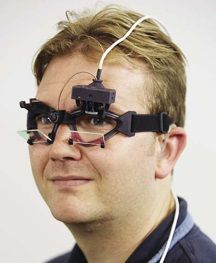Calorics and vHIT: Do We Really Need Both?

With the advent of Video Head Impulse Testing (vHIT), many researchers and clinicians alike have questioned whether or not we really need to include both tests in our assessment of vestibular function. Are the long, laborious and uncomfortable caloric irrigations really necessary anymore when we have access to a much simpler, quicker tool that can assess the semicircular canals?

Some have proposed that we do not need calorics anymore and that vHIT is an alternative and superior tool (MacDougall et al, 2009) to the caloric test, which has a long-standing reputation as the gold standard test for assessing loss of vestibular function.
vHIT is an exciting and relatively new tool for assessment of the vestibular system with certain advantages over caloric testing. For example, the amount of time to complete an evaluation is significantly reduced for vHIT, and the stimulus is much less likely to cause nausea for the patient. vHIT is also an effective test for evaluation of semicircular canal function in the pediatric population and may be able to provide information when caloric testing is contraindicated (Hamilton et al, 2015).
Yet another distinct advantage of vHIT testing is that it stimulates the VOR using a more physiological high frequency stimulus than caloric testing. In spite of these advantages, caloric testing has been shown to have a high degree of sensitivity and specificity in the evaluation of unilateral vestibulopathy (Eza-Nunez et al, 2014).
Advantages and disadvantages aside, the overwhelming conclusion is that calorics and vHIT do not provide redundant information regarding horizontal semicircular canal function but, instead, are complementary to one another (McCaslin et al, 2014). Although both tests do assess the vestibulo-ocular reflex (VOR), they stimulate different temporal frequencies of this reflex (Redondo-Martinez et al, 2015).
The caloric response stimulates the vestibular system at a very low frequency of approximately .003 Hz, while vHIT is performed by the examiner thrusting the patient’s head in a much higher frequency range up to 5 Hz. As a result, the vHIT and the caloric show different VOR responses (Redondo-Martinez et al, 2015).
According to Zellhuber et al (2014), the dissociation between caloric and vHIT results may be a reflection of the temporal frequency differences, but may also be due to the differing roles of regular and irregular fibers of the vestibular nerve. The authors explain that animal studies have demonstrated some evidence that regular fibers drive the low frequency VOR, while irregular fibers drive the high frequency VOR.
Several studies have concluded that vHIT doesn’t outweigh calorics, but that calorics and vHIT both provide useful information in the diagnosis of a variety of different disorders affecting the vestibular system, including vestibular migraine (Yoo, et al, 2015), vestibular schwannoma (Blödow et al, 2013, Tranter-Entwistle et al, 2016), and vestibular neuritis (Redondo-Martinez et al, 2015, Zellhuber et al, 2014).
With respect to Ménière’s disease, studies have shown that caloric results are more often abnormal than vHIT results (McCaslin et al, 2015). There are Ménière’s disease cases where pathology will appear in vHIT, but more commonly, the vHIT is relatively normal, while the caloric responses are more sensitive in detecting the pathology.
Blödow et al (2014) reported that only 37% of the Ménière’s patients they studied demonstrated abnormal vHIT. In chronic vestibular pathology, caloric testing is also more sensitive than vHIT (Burston et al, 2014). This evidence provides additional support to disclaim the theory that calorics are no longer necessary.
While the reason for the differences between the two tests still remains somewhat unclear, there is plenty of evidence in the literature to suggest that the information derived from each test is important and that they assess different parts of the VOR. The review of recent literature indicates that vHIT is not a replacement for caloric testing but, rather, is another tool to keep in our vestibular assessment toolbox. Both calorics and vHIT remain necessary parts of the multidimensional vestibular assessment battery.
References
Blödow, A, Helbig, R, Wichmann, N, Wenzel, A, Walther, LE, Bloching, MB (2013). Video head impulse test or caloric irrigation? Contemporary diagnostic tests for vestibular schwannoma. HNO 61(9), 781-185.
Blödow, A, Heinze, M, Boris Bloching, M, Von Brevern, M, Radtke, A, Lempert, T (2014). Caloric stimulation and video-head impulse testing in Ménière’s disease and vestibular migraine. Acta Oto-Laryngologica 134, 1239-1244.
Eza-Nunez, P, Farinas-Alvarez, C, Perez-Fernandez, N (2014). The caloric test and the video head-impulse test in patients with vertigo. Int adv Otol 10(2), 144-149.
Hamilton, SS, Zhou, G, Brodsky, JR (2015). Video head impulse testing (vHIT) in the pediatric population. Int J Pediatr Otorhinolaryngol 79, 1283-1287.
MacDougall, HG, Weber, KP, McGarvie, LA, Halmagyi, GM, Curthoys, IS (2009). The video head impulse Test: Diagnostic accuracy in peripheral vestibulopathy. Neurology 73(14), 1134-1141.
McCaslin, DL, Jacobson, GP, Bennett, ML, Gruenwald, JM, Green AP (2014). Predictive properties of the Video head impulse test: Measures of caloric symmetry and self-report dizziness handicap. Ear Hear 35(5), e185-e191.
McCaslin, D, Rivas, A, Jacobson, G, Bennett, M (2015). The dissociation of video head impulse test (vHIT) and bithermal caloric test results provide topological localization of vestibular system impairment in patients with “definite” Ménière’s disease. AJA 24, 1-10
Redondo-Martinez, J, Becares-Martinez, C, Orts-Alborch, M, Garcia-Callejo, FJ, PerezCarbonell, T, Marco-Algarra, J (2015). Relationship between video head impulse test (vHIT) and caloric test in patients with vestibular neuritis. Acta Otorrinolaryngol Esp 67(3), 156-161.
Tranter-Entwistle, I, Dawes, P, Darlington, CL, Smith PF, Cutfield, N (2016). Video head impulse in comparison to caloric testing in unilateral vestibular schwannoma. Acta Otolaryngol 136(11), 1110-1114.
** Yoo, MH, Kim, SH, Lee, JY, Yang, CJ, Lee, HS, Park, HJ** (2015). Results of video head impulse and caloric tests in 36 patients with vestibular migraine and 23 patients with vestibular neuritis: A preliminary report. Clin Otolaryngol 41(6), 813-817.
Zellhuber, S, Mahringer, A, Rambold HA (2014). Relation of video-head-impulse test and caloric irrigation: A study on the recovery in unilateral vestibular neuritis. Eur Arch Otorhinolaryngol 271, 2375-2383.
